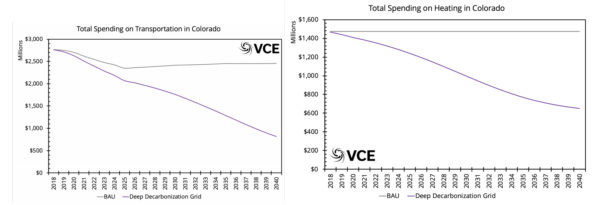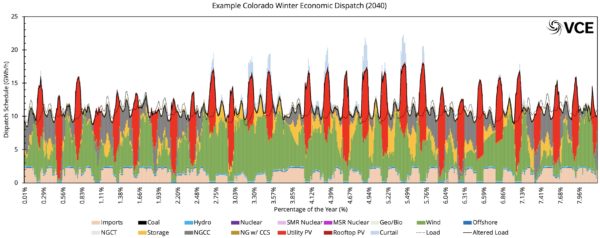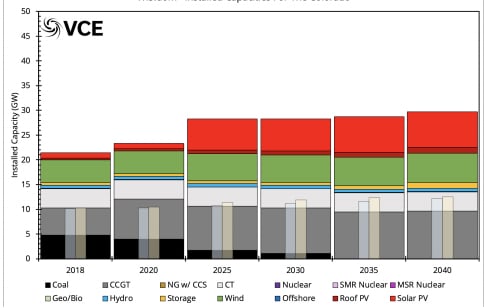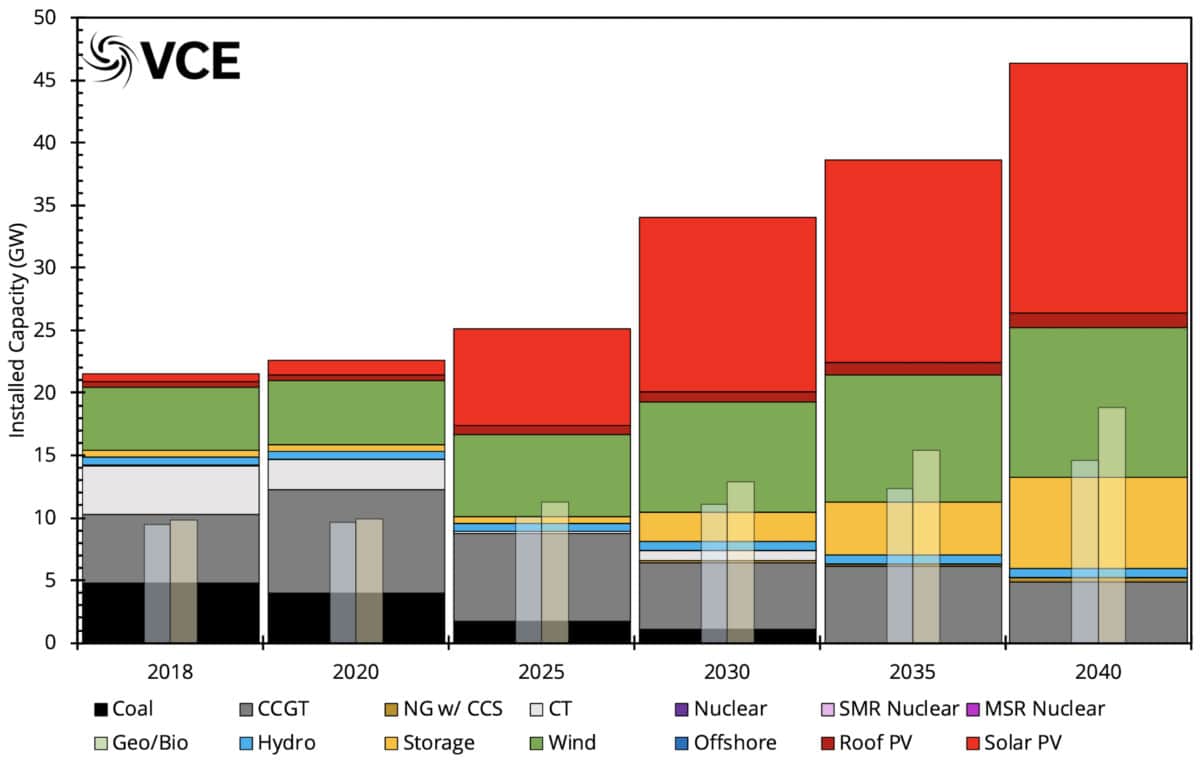Electrifying most transportation and heating in Colorado would allow more low-cost renewables on the grid, thus lowering the cost per kilowatt-hour for all consumers in the state, and accelerating achievement of Colorado’s carbon reduction goals.
Solar capacity in Colorado (shown in red above) would soar to about 15 GW by 2030 and 21 GW by 2040, in an “electrification and decarbonization” scenario modeled by Vibrant Clean Energy, using its WIS:dom energy grid model. Also by 2040, storage with 8 hour duration would reach 7.4 GW (shown in yellow), and wind power would reach 12 GW (shown in green). The study was commissioned by Community Energy.
High levels of solar, wind and storage were facilitated in the model by flexible scheduling of both electric vehicle charging and heat pump operation. Flexible charging for vehicles was constrained to maintain round-trip commuting range, while flexible heat pump operation was constrained to keep building indoor temperatures within 1 degree of 72ºF. The modeling assumed that owners of electric vehicles and heat pumps would participate in flexible scheduling for a compensation of six cents per kWh.
Buildings were also modeled as having backup heating—either supplemental gas or electric heating—because air-source heat pumps lose efficiency on the very coldest days.
Not just Colorado
The findings indicate the savings possible in other states from electrification and increased renewables, said Vibrant Clean Energy CEO Dr. Christopher Clack:
The Community Energy-commissioned study [shows] that electrification can be a tool that achieves economy-wide emission reductions at a cost lower than focusing solely on the electricity sector. There will be differences, but this study and a study we did last year (Minnesota Smarter Grid) show very similar characteristics: electrification facilitates more variable renewable energy and decarbonizes faster than concentrating on a single sector.”
Lower costs to get around and stay warm
Beyond projecting electricity costs, the modeling also projected total spending for transportation and heating, which would each decline by more than half, as adoption of electric vehicles and heat pumps increased through 2040, and their operating costs would be lower:

The flexible demand made possible by electrification—both in charging of vehicles and heating of buildings—helps makes possible far more low-cost solar and wind power, such that electric rates would decline by 7% compared to a “retire coal early” scenario without electrification of transport and heating.
Grid operation in 2040 with deep decarbonization
“The dispatch of the new system will present challenges and opportunities” says the report, pointing to a five-minute dispatch profile for a winter month, January 2040, in which storage, gas-fired generation, and modest imports fill in around solar (red) and wind (green) generation:

Employment gains
The report says that the increase in renewable generation capacity, which would increase employment in Colorado’s electricity sector by about 65% by 2040 in a “retire coal early” scenario that was also modeled, would nearly double the sector’s employment in the deep decarbonization scenario by 2040.
Technical notes
Vibrant Clean Energy’s report is titled Colorado Electrification & Decarbonization Study; modeling inputs and outputs are also available.
For future costs of solar capacity, the analysis referenced the National Renewable Energy Laboratory’s 2019 Annual Technology Baseline (ATB), as well as Colorado Public Utilities Commission filings (e.g., for price data from recent solar contracts); selected the ATB low case cost projections for standard, mono-facial PV; and assumed that new PV in Colorado would use bifacial technology yielding a 10% increase in production at a 5% higher cost. The report states that overall, “the costs used in the modeling for new technologies were conservative and cost savings could be even higher.”
The rate of electrification adoption was constrained in the modeling not to exceed rates reflected in the National Renewable Energy Laboratory (NREL) Electricity Futures Study (EFS) “high (moderate advancement)” electrification dataset. The report explains: “The EFS dataset allows up to 80% of ground-based transportation to be electrified through battery vehicles, hybrid vehicles and fuel cell vehicles by 2040. The heating is at a slower adoption rate, achieving approximately 60% electrification (including hydrogen production) of space and water heating.”
In the top image, showing two narrow vertical bars within each wide vertical bar, each narrow bar on the left shows the peak demand based on the demand inputs to the model, and each narrow bar on the right shows the modeled peak demand after some demand, and some charging of storage, is shifted to times of peak solar production.
The modeling devoted some electricity to hydrogen production, with one modeled hydrogen facility having a utilization of 70%.
For comparison with the “electrification and decarbonization” results presented above, a scenario with early coal retirement but without electrification of vehicles and transport showed significantly less renewable and storage capacity, and more fossil capacity:

This content is protected by copyright and may not be reused. If you want to cooperate with us and would like to reuse some of our content, please contact: editors@pv-magazine.com.








Exactly — Thank you for reporting on this reality that we can finance our transition off fossil energy from the savings alone: “the modeling also projected total spending for transportation and heating, which would each decline by more than half, as adoption of electric vehicles and heat pumps increased through 2040”!
It is becoming apparent that Solar Energy can replace ALL Energy needs…. and not just Electricity… IF WE WANT TO & DEMAND A ZERO POLLUTION WORLD.
However the USA would require a 10-12TW Solar System.
At present (2019) the US uses ~100Quad (30,000TWhr) of Primary Energy Annually…. of which only 33Quad(10,000TWhr) are used and the Balance…. wasted as Conversion Losses mostly in Power Generation, Vehicles, HVAC, Industry… etc.. In an ALL ELECTRIC SYSTEM most of these Losses would be minimal… 10-15%… or even lower.
Assuming we need about 12,000TWhr/yr of Electricity, the USA would need a 10TW System (@1,200KWhr/KW/yr)…. say 10-12TW. This requires an INVESTMENT (not an EXPENDITURE… like the $3Trillion COVID Relief fund created by Congress “overnite”) of about $15-20Trillion (including Overnite Energy Storage)…. Generating $1.2Trillion/yr of Electricity (@ $0.1/KWhr)…
YES… WE CAN DO IT… IF WE WANT AND IN THE PROCESS PRESERVE & RESTORE OUR HEALTH, ENVIRONMENT, JOBS & FINANCES TOO….
IT IS UPTO US ONLY…. BUT WILL REQUIRE USE OF AGRIVOLTAICS ON <<10% OF THE EXISTING AGRICULTIRAL LAND FOR THIS MULTI-TW SOLAR SYSTEM, REVITALIZING THE COUNTRYSIDE IN THIS PROCESS.